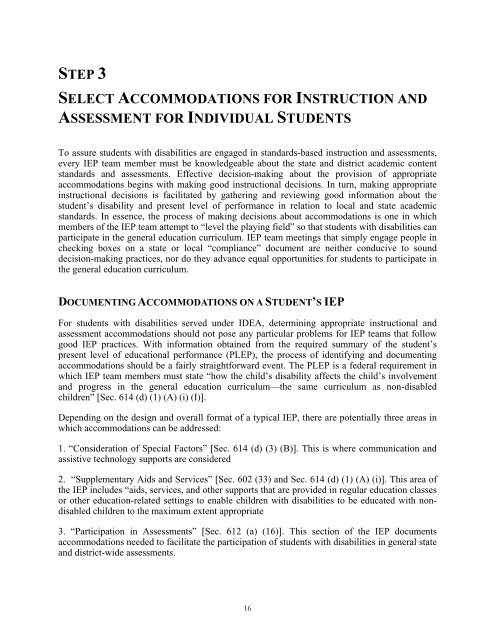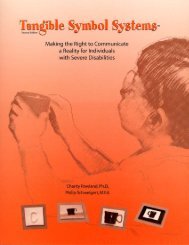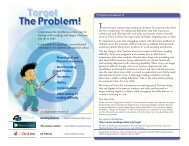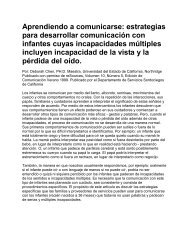ACCOMMODATIONS MANUAL - The Office of Special Education ...
ACCOMMODATIONS MANUAL - The Office of Special Education ...
ACCOMMODATIONS MANUAL - The Office of Special Education ...
You also want an ePaper? Increase the reach of your titles
YUMPU automatically turns print PDFs into web optimized ePapers that Google loves.
STEP 3<br />
SELECT <strong>ACCOMMODATIONS</strong> FOR INSTRUCTION AND<br />
ASSESSMENT FOR INDIVIDUAL STUDENTS<br />
To assure students with disabilities are engaged in standards-based instruction and assessments,<br />
every IEP team member must be knowledgeable about the state and district academic content<br />
standards and assessments. Effective decision-making about the provision <strong>of</strong> appropriate<br />
accommodations begins with making good instructional decisions. In turn, making appropriate<br />
instructional decisions is facilitated by gathering and reviewing good information about the<br />
student’s disability and present level <strong>of</strong> performance in relation to local and state academic<br />
standards. In essence, the process <strong>of</strong> making decisions about accommodations is one in which<br />
members <strong>of</strong> the IEP team attempt to “level the playing field” so that students with disabilities can<br />
participate in the general education curriculum. IEP team meetings that simply engage people in<br />
checking boxes on a state or local “compliance” document are neither conducive to sound<br />
decision-making practices, nor do they advance equal opportunities for students to participate in<br />
the general education curriculum.<br />
DOCUMENTING <strong>ACCOMMODATIONS</strong> ON A STUDENT’S IEP<br />
For students with disabilities served under IDEA, determining appropriate instructional and<br />
assessment accommodations should not pose any particular problems for IEP teams that follow<br />
good IEP practices. With information obtained from the required summary <strong>of</strong> the student’s<br />
present level <strong>of</strong> educational performance (PLEP), the process <strong>of</strong> identifying and documenting<br />
accommodations should be a fairly straightforward event. <strong>The</strong> PLEP is a federal requirement in<br />
which IEP team members must state “how the child’s disability affects the child’s involvement<br />
and progress in the general education curriculum—the same curriculum as non-disabled<br />
children” [Sec. 614 (d) (1) (A) (i) (I)].<br />
Depending on the design and overall format <strong>of</strong> a typical IEP, there are potentially three areas in<br />
which accommodations can be addressed:<br />
1. “Consideration <strong>of</strong> <strong>Special</strong> Factors” [Sec. 614 (d) (3) (B)]. This is where communication and<br />
assistive technology supports are considered<br />
2. “Supplementary Aids and Services” [Sec. 602 (33) and Sec. 614 (d) (1) (A) (i)]. This area <strong>of</strong><br />
the IEP includes “aids, services, and other supports that are provided in regular education classes<br />
or other education-related settings to enable children with disabilities to be educated with nondisabled<br />
children to the maximum extent appropriate<br />
3. “Participation in Assessments” [Sec. 612 (a) (16)]. This section <strong>of</strong> the IEP documents<br />
accommodations needed to facilitate the participation <strong>of</strong> students with disabilities in general state<br />
and district-wide assessments.<br />
16





